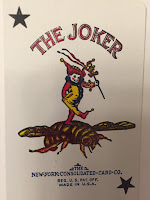Two of my friends recently bought decks for me on their travels. These decks were both bought in Latin countries (Spain and Italy) so they are not American-style decks which for those of you who don't know, is largely the same as British decks which are almost the same as French which is where our decks descend from.
Both of the gifted decks (and thank you both very much) were in the category that I think of as Latin decks. In this case, the decks came from Spain and Italy, specifically Sicily. How are Latin decks different? Well, let's look.
Clubs: Like American decks, they have a suit called clubs. But their clubs look like real clubs, like the sort of club a Fred Flintstone might have used. Here is the five of clubs and two of clubs from these decks.
 |
| A Latin-style Five and Two of Clubs |
Size. You might also notice that these two decks are different sizes. And neither is exactly the same size as an American deck. Here is the three of swords (or spades) from left to right of the Sicilian deck, an American deck, and the Spanish deck.
Suits. Here are the four suits from the Spanish deck. They have Swords (like our Spades), Coins (like our Diamonds), Cups (like our hearts), and Clubs, which we've already looked at. These are the same suits from the Sicilian deck. Notice any red or black suits?
 |
| Suits of the Spanish Deck: Swords, Coins, Cups, and Clubs |
 |
| The Six Highest Club Cards in the Spanish deck |
 |
| The Most Ornate Cards - Trademarks |
Here are the four ones from the Spanish and Sicilian decks so you can see how the one of coins got the most elaborate treatment.
 |
| Ones of Coins, Swords, Clubs, and Cups |
 | |
The Trademark is one the Coins card Sicilian Deck |
 |
| Top Six Cup Cards in the Sicilian Deck |
 |
| Spanish Jokers and Back |
 |
| Sicilian Box (The Spanish deck did not have a box) |
There is a third broad category of European decks of cards: the German decks. German-suited playing cards are a very common style of traditional playing card used in many parts of Central Europe characterised by 32- or 36-card packs with the suits of Acorns (Eichel or Kreuz), Leaves (Grün, Blatt, Laub, Pik or Gras), Hearts (Herz or Rot) and Bells (Schelle, Schell or Bolle). The German suit system is one of the oldest, becoming standard around 1450 and, a few decades later, influencing the design of the now international French suit system of Clubs, Spades, Hearts and Diamonds. (Thanks to Wikipedia for this party).
- Ensemble Animal combinations (cats AND dogs)
- Cats or Dogs . Felines, Canines. And a big cat subsection!
- Flyers: Birds, Owls, Bees, Butterflies & Dragons . With a rooster & chicken subsubsection!
- Horses , zebras, donkeys, giraffes. Equestrian!
- Fantasy horses: centaurs, unicorns, Pegasuses
- Monkeys, bears, and other sapiens (yes, missing links jokers go here). Panda Bears are a subsection.
- Animals with antlers, horns, and tusks
- Varmints - the small wild animals
- Reptiles, amphibians, sea creatures, mermaids, shell fish,
 |
| Animals: Flyers - Bee Boy |





















































